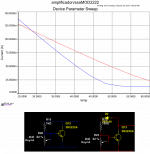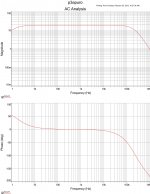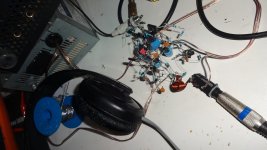Member
Joined 2009
Paid Member
Looks interesting!
You have to be careful about thermal management of the VAS current. With symmetrical designs the VAS current isn't contolled by the nfb loop as it is with the baseline TGM8. I have tried a symmetrical design in the past ( TGM6 ) where I used a bit more degeneration on the VAS ( I used too much ) and a slightly better Vbe multiplier which did not increase the bias voltage to the output stage if the VAS current increased from temperature rises - I suggest you adopt the same Vbe multiplier design.
I hope you are going to develop this into a working amplifier 🙂
You have to be careful about thermal management of the VAS current. With symmetrical designs the VAS current isn't contolled by the nfb loop as it is with the baseline TGM8. I have tried a symmetrical design in the past ( TGM6 ) where I used a bit more degeneration on the VAS ( I used too much ) and a slightly better Vbe multiplier which did not increase the bias voltage to the output stage if the VAS current increased from temperature rises - I suggest you adopt the same Vbe multiplier design.
I hope you are going to develop this into a working amplifier 🙂
understand, are you sure that is the tgm6? the scheme that saw its symmetrical was tgm5, he has a diode with vbe transistor.
by the way why you prefer tgm8 about 5?
by the way why you prefer tgm8 about 5?
Member
Joined 2009
Paid Member
You're right, it was TGM5 !
To me, I find the sound of TGM8 better than TGM5 in all regards - treble, mids, bass, musicality, clarity, refinement etc. I wouldn't blame this on the symmetric architecture too quickly though, my implementation of it in TGM5 may not have been good enough. My other symmetric amp was TGM7 and it sounds way better than my TGM5. There's also the factor of personal preference, some people say they prefer asymmetric amplifiers (Hugh Dean as an example) and there are people who say that the PASS Aleph sounds better than the PASS F5.
To me, I find the sound of TGM8 better than TGM5 in all regards - treble, mids, bass, musicality, clarity, refinement etc. I wouldn't blame this on the symmetric architecture too quickly though, my implementation of it in TGM5 may not have been good enough. My other symmetric amp was TGM7 and it sounds way better than my TGM5. There's also the factor of personal preference, some people say they prefer asymmetric amplifiers (Hugh Dean as an example) and there are people who say that the PASS Aleph sounds better than the PASS F5.
cool, returning to vbe I did a comparison:

really with the diode is more linear / constant, however my vbe will be along with the driver, I believe they will not exceed 50 degrees, maybe the common vbe would be better? and remembering that the P3A is even thermally coupled, are just next vbe / driver.
you some time measured the temp of tgm8 drivers?

really with the diode is more linear / constant, however my vbe will be along with the driver, I believe they will not exceed 50 degrees, maybe the common vbe would be better? and remembering that the P3A is even thermally coupled, are just next vbe / driver.
you some time measured the temp of tgm8 drivers?
Well in sonic signature ( sonic signature is what made P3A world class hit is a combination of one LTP one bootstrap and sziklai output stage )
Going other roads like singleton input +bootstrap+sziklai will enhance the above sonic signature tone and musicality but in reality amplifier eventhough colorful will not be that accurate ...
Using a diamond input if manage to preserve a low amount of offset since this type of input style will be depending on the exact hfe of the specific transistors Poor choice of parts will produce offset . I wonder also if thermal coupling is in order here
Finally we have seen this type of input stages often in elektor circuits and i could say that the general result is too much hustle for a result that has very few things to offer next to a simple well matched and thermally coupled LTP
Kind regards
Sakis
Going other roads like singleton input +bootstrap+sziklai will enhance the above sonic signature tone and musicality but in reality amplifier eventhough colorful will not be that accurate ...
Using a diamond input if manage to preserve a low amount of offset since this type of input style will be depending on the exact hfe of the specific transistors Poor choice of parts will produce offset . I wonder also if thermal coupling is in order here
Finally we have seen this type of input stages often in elektor circuits and i could say that the general result is too much hustle for a result that has very few things to offer next to a simple well matched and thermally coupled LTP
Kind regards
Sakis
Member
Joined 2009
Paid Member
Well in sonic signature ( sonic signature is what made P3A world class hit is a combination of one LTP one bootstrap and sziklai output stage )
Hi, good points, I know you like much of P3A and has as a reference, based on various comments and especially their I built a P3A (still unfinished).
Well, what I thought enstranho in your comment was about the accuracy of the combination: input + (bootstrap) + Sziklai, this circuit does not use the bootstrap.
* In any case let us 2 graphics ac analisys of P3A simulator vs this variant.
But what? simulations? unfortunately yes, I no have test equipment, much less money =)
* I know, I know, we can not hear sound or obtain performance = to the real world, but it will be a little illustration on accuracy.
P3A:

vssa + mod:

but once, I know, simulations ... good, the biggest difference is the phase, this can be audible? I do not know, probably not to some extent, but we are talking about precision
I understand very little of electronics, if you can clarify your point, I thank you, even more.
Last edited:
Member
Joined 2009
Paid Member
It's good to have some ability to do simulations, I have found it invaluable. But you do have to listen to the amplifier - simulation provides a limited reference for the final sound. If you interpret 'accuracy' to mean low distortion - there are many amplifiers with lower distortion than P3A (on paper, TGM8 is one of them) but this is a technical interpretation whereas some people use the word 'accuracy' to describe a subjective experience of the sound.
This isn't the thread to debate Singleton input vs LTP input though (as I'm sure there are dedicated threads on the topic around her somewhere) - but there are pro's and con's of both approaches. Both can be designed to perform excellently, such that the distortion of the amplifier is not limited by the input in either case. I haven't listened to as many amplifiers as others, Sakis included, but subjectively I have found amplifiers with a Singleton input to sound very nice indeed.
This isn't the thread to debate Singleton input vs LTP input though (as I'm sure there are dedicated threads on the topic around her somewhere) - but there are pro's and con's of both approaches. Both can be designed to perform excellently, such that the distortion of the amplifier is not limited by the input in either case. I haven't listened to as many amplifiers as others, Sakis included, but subjectively I have found amplifiers with a Singleton input to sound very nice indeed.
Last edited:
Finally we have seen this type of input stages often in elektor circuits and i could say that the general result is too much hustle for a result that has very few things to offer next to a simple well matched and thermally coupled LTP
Kind regards
Sakis
I can't comment on the Elektor circuits, because I've never built nor heard one. I've looked at a few of their schematics and what I saw didn't really inspire confidence.
But I've spent a huge amount of time with the P3A. I've built stock standard versions on Rod's boards, I've tried exotic components, I've tweaked the circuit and designed/built boards with my own modifications.
I find it very difficult to believe that anybody who likes the P3A sound and has actually listened to Gareth's TGM8 would dislike it.
test mod
Hi, I decided to build a version of 1w for testing purposes with headphone, to see how loudly and the thermal stability and the dc offset.
* Current stable at 33mA. (no thermal coupling)
* dc off set: 4.5 mv:: Yikes:: Yikes: (no combined components, hfe, resistor ....)
* no oscillation even with "bad layout":
* Generic components used

good, as the sound, I have a very good amp testato and balanced, O2 heaphone amplifier, to make a comparison, I will be brief, after 5h comparisons:
bass: I did not notice a difference.
medios: very similar, perhaps the modvssa is only a little clearer in instruments.
vocal, tonal quality: not see the difference.
highs: there is a small difference, the O2 is a little softer, but just as departure is a little less realistic cymbals.
soundstage: very hard to see that difference already tested in mono.
How revealing is the amp? : The modvssa if only showed a little, very little even more revealing.
end result? are very similar, differences very, very subtle, there are songs that you have to grated to see differences.
so I think this amp is on the side of precision, and not as colorful and inaccurate sakis talked, now definitely will be this amp that will mount, and a version for headphone too, that this test was not quite right with this circuit point by point, generic components, and source not very good.
in the future, maybe I will compare the P3A with this mod, the only thing I know is that the P3A will enter a dead end. : Headbash:: Headbash:: Headbash:
Hi, I decided to build a version of 1w for testing purposes with headphone, to see how loudly and the thermal stability and the dc offset.
* Current stable at 33mA. (no thermal coupling)
* dc off set: 4.5 mv:: Yikes:: Yikes: (no combined components, hfe, resistor ....)
* no oscillation even with "bad layout":
* Generic components used

good, as the sound, I have a very good amp testato and balanced, O2 heaphone amplifier, to make a comparison, I will be brief, after 5h comparisons:
bass: I did not notice a difference.
medios: very similar, perhaps the modvssa is only a little clearer in instruments.
vocal, tonal quality: not see the difference.
highs: there is a small difference, the O2 is a little softer, but just as departure is a little less realistic cymbals.
soundstage: very hard to see that difference already tested in mono.
How revealing is the amp? : The modvssa if only showed a little, very little even more revealing.
end result? are very similar, differences very, very subtle, there are songs that you have to grated to see differences.
so I think this amp is on the side of precision, and not as colorful and inaccurate sakis talked, now definitely will be this amp that will mount, and a version for headphone too, that this test was not quite right with this circuit point by point, generic components, and source not very good.
in the future, maybe I will compare the P3A with this mod, the only thing I know is that the P3A will enter a dead end. : Headbash:: Headbash:: Headbash:
Member
Joined 2009
Paid Member
My Gosh - I'd never have thought it possible to build a TGM8 in that style of construction !!!!
I congratulate you 🙂
Interesting comparison of sound, thank you for sharing that.
I congratulate you 🙂
Interesting comparison of sound, thank you for sharing that.
My Gosh - I'd never have thought it possible to build a TGM8 in that style of construction !!!!
I congratulate you 🙂
Interesting comparison of sound, thank you for sharing that.
thanks : P: P: P
remember that not is tgm8 pure, it is the schema post 700.
http://www.diyaudio.com/forums/atta...8-amplifier-based-rod-elliot-p3a-untitled.jpg
Last edited:
That's dead bug style after someone stood on the hive.
: D: D: D: D: D: D: D: D
Member
Joined 2009
Paid Member
remember that not is tgm8 pure
no problem, it's all 'family' 🙂
Nice work duartejunior! Sure beats spending weeks and weeks laying out and waiting for PCBs to arrive just to try something
Hi, I decided to build a version of 1w for testing purposes with headphone, to see how loudly and the thermal stability and the dc offset.
please iguinore the subjective part of this poster, these differences gave thanks to different volume levels of each amp and the time to change the connector, I installed a test key A / B for instantaneous change and equaled the volume correctly.
And surprise, they sound identical to me, in many songs I can see no difference in any way.
honestly I'm not believing, O2 uses JRC4556 chip has an input topology and different output of the circuit posted here, and yet they sound identical to me. incredible!
Bigun if the tgm8 have sound like this (I believe so), you have a really transparent amp, but you already know that.
That's what an amplifier should not do, intrude into the music.
Last edited:
Nice work duartejunior! Sure beats spending weeks and weeks laying out and waiting for PCBs to arrive just to try something
yes, this is just for testing whether everything works, I do not want to lose an entire pcb since I do them manually, in a 60 to 90 days I post photos completed, this is the average time it takes to reach the components of ebay .
please read my previous message.
I thought this was an interesting circuit, it reminds me of the TGM8. We have a Singleton input stage and a CFP output.
The original precursor to this. See the only compensation at 220pf.
It is a full constructional article, including a pcb layout and HART offered kits. I had the original issue, now missing after three moves.
Attachments
Last edited:
- Home
- Amplifiers
- Solid State
- TGM8 - my best amplifier, incredible bass, clear highs, no fatigue (inspired by Rod Elliot P3a)
